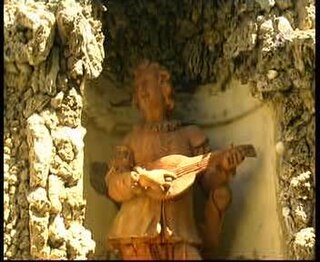Year 1409 (MCDIX) was a common year starting on Tuesday of the Julian calendar.

Mino da Fiesole, also known as Mino di Giovanni, was an Italian sculptor from Poppi, Tuscany. He is noted for his portrait busts.

Desiderio da Settignano, real name Desiderio de Bartolomeo di Francesco detto Ferro was an Italian sculptor active during the Renaissance.

San Miniato al Monte is a basilica in Florence, central Italy, standing atop one of the highest points in the city. It has been described as one of the finest Romanesque structures in Tuscany and one of the most scenic churches in Italy. There is an adjoining Olivetan monastery, seen to the right of the basilica when ascending the stairs.

The cultural and artistic events of Italy during the period 1400 to 1499 are collectively referred to as the Quattrocento from the Italian for the number 400, in turn from millequattrocento, which is Italian for the year 1400. The Quattrocento encompasses the artistic styles of the late Middle Ages, the early Renaissance, and the start of the High Renaissance, generally asserted to begin between 1495 and 1500.

Settignano is a frazione on a hillside northeast of Florence, Italy, with views that have attracted American expatriates for generations. The little borgo of Settignano carries a familiar name for having produced three sculptors of the Florentine Renaissance, Desiderio da Settignano and the Gamberini brothers, better known as Bernardo Rossellino and Antonio Rossellino. The young Michelangelo lived with a sculptor and his wife in Settignano—in a farmhouse that is now the "Villa Michelangelo"— where his father owned a marble quarry. In 1511 another sculptor was born there, Bartolomeo Ammannati. The marble quarries of Settignano produced this series of sculptors.
Rossellini is a common Italian family name in Italy. Other spellings include: Rosselini.

The Basilica of St. Stephen in the Round on the Celian Hill is an ancient basilica and titular church in Rome, Italy. Commonly named Santo Stefano Rotondo, the church is Hungary's "national church" in Rome, dedicated to both Saint Stephen, the first Christian martyr, and Stephen I, the sanctified first king of Hungary who imposed Christianity on his subjects. The minor basilica is also the rectory church of the Pontifical Collegium Germanicum et Hungaricum.

Benedetto da Maiano was an Italian sculptor of the early Renaissance.
De Rossi is an Italian surname, and may refer to:
The decade of the 1420s in art involved some significant events.

Villa Gamberaia is a seventeenth-century villa near Settignano, outside Florence, Tuscany, Italy.

The Master of the Marble Madonnas was the name given to an unidentified sculptor, or perhaps group of sculptors, active in the Tuscan region of Italy between c. 1470 and c.1500. He is thought to have been responsible for a group of stylistically related sculptures that is based mainly on their related compositions and drapery forms. Products of the Master's workshop include a large number of reliefs of the Virgin and Child; busts and reliefs depicting the suffering of Christ were also popular, as were busts of children. Various mannerisms can be seen in this group, as well; among these has been what is described as "a peculiar feline smile from heavy-lidded eyes and a taut jaw, at its best radiating inward joy but often acerbic or bordering on the manic"

An anonymous author known as the Anonimo Gaddiano, Anonimo Magliabechiano, or Anonimo Fiorentino is the author of the Codice Magliabechiano or Magliabechiano, a manuscript with 128 pages of text, probably from the 1530s and 1540s, and now in the Central National Library of Florence. It includes brief biographies and notes on the works of Italian artists, mainly those active in Florence during the Middle Ages. Among several other suggestions, the anonymous author has been suggested to be Bernardo Vecchietti (1514–1590), a politician of the court of Cosimo I. The author clearly had intimate access to the Medici court.
This page is based on this
Wikipedia article Text is available under the
CC BY-SA 4.0 license; additional terms may apply.
Images, videos and audio are available under their respective licenses.











